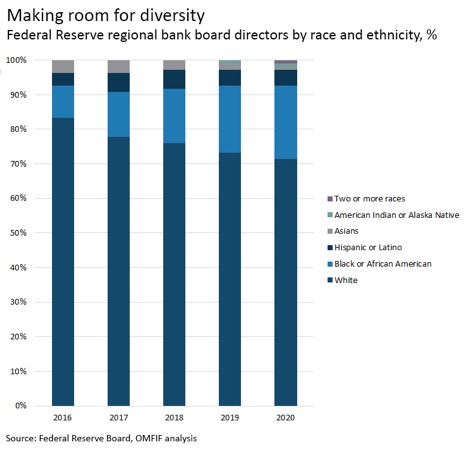Kat Usita: Central Banks’ Diversity Problem
2020-06-22 IMI Similarly, the Bank of England lacks minority representation in top positions, but publicly acknowledges the problem and sets targets for improvement. Only 5% of senior management are from black, Asian and minority ethnic backgrounds, less than half of its target 13%. Its governor, deputy governors and chief operating officer are all white, and COO Joanna Plaice is the lone woman in this executive team. No person of colour has ever served as governor. The monetary policy committee is all-white, and only one out of its nine members is a woman.
To help correct this, the BoE has a number of networks meant to support its staff and encourage inclusion. There is a BAME network, as well as religion-based groups to help connect colleagues with similar backgrounds. The BoE also implements sponsorship programmes to support the upwards progression of BAME staff.
The European Central Bank has yet to publish figures on the racial and ethnic breakdown of its senior management, although the absence of diversity in the top governing bodies is clear. In 22 years, no person of colour has served on its executive board. The governing council, which includes the executive board and the 19 governors of national central banks in the euro area, is entirely white. There is also a striking lack of gender diversity, as President Christine Lagarde and board member Isabel Schnabel are the only women in these groups.
Like the Fed and BoE, the ECB recognises the need for improving diversity, and has networks and programmes that promote a more balanced and representative workforce. There could be more diversity in the lower rungs of the Eurosystem, but without data available, the homogeneity in top positions is glaring.
The effectiveness of monetary policy should ultimately be judged by how well it serves ordinary workers and consumers, especially the most vulnerable, in times of widespread economic uncertainty. Decision-makers in central banks must bear in mind the specific difficulties that different racial and ethnic groups face, and represent those realities in policy formulation. They need to veer away from groupthink, or the tendency to gravitate towards the dominant perspective. Without diverse views on the table, central banks will end up serving only a segment of the economy they are meant to protect.
Similarly, the Bank of England lacks minority representation in top positions, but publicly acknowledges the problem and sets targets for improvement. Only 5% of senior management are from black, Asian and minority ethnic backgrounds, less than half of its target 13%. Its governor, deputy governors and chief operating officer are all white, and COO Joanna Plaice is the lone woman in this executive team. No person of colour has ever served as governor. The monetary policy committee is all-white, and only one out of its nine members is a woman.
To help correct this, the BoE has a number of networks meant to support its staff and encourage inclusion. There is a BAME network, as well as religion-based groups to help connect colleagues with similar backgrounds. The BoE also implements sponsorship programmes to support the upwards progression of BAME staff.
The European Central Bank has yet to publish figures on the racial and ethnic breakdown of its senior management, although the absence of diversity in the top governing bodies is clear. In 22 years, no person of colour has served on its executive board. The governing council, which includes the executive board and the 19 governors of national central banks in the euro area, is entirely white. There is also a striking lack of gender diversity, as President Christine Lagarde and board member Isabel Schnabel are the only women in these groups.
Like the Fed and BoE, the ECB recognises the need for improving diversity, and has networks and programmes that promote a more balanced and representative workforce. There could be more diversity in the lower rungs of the Eurosystem, but without data available, the homogeneity in top positions is glaring.
The effectiveness of monetary policy should ultimately be judged by how well it serves ordinary workers and consumers, especially the most vulnerable, in times of widespread economic uncertainty. Decision-makers in central banks must bear in mind the specific difficulties that different racial and ethnic groups face, and represent those realities in policy formulation. They need to veer away from groupthink, or the tendency to gravitate towards the dominant perspective. Without diverse views on the table, central banks will end up serving only a segment of the economy they are meant to protect.
